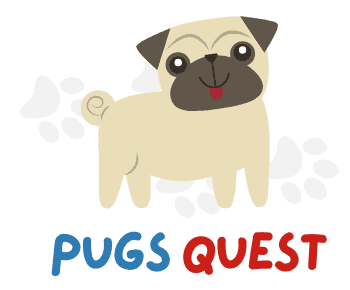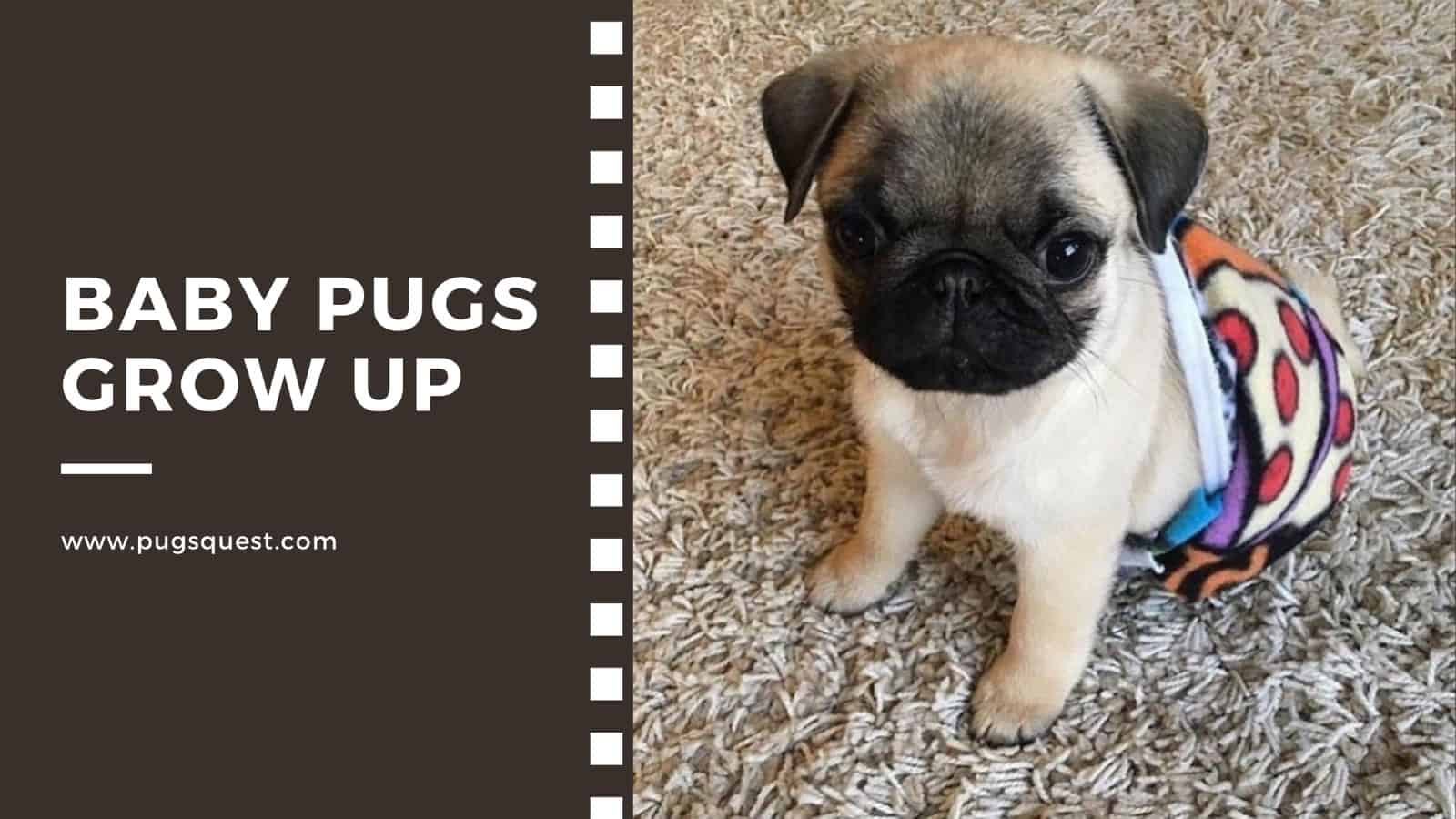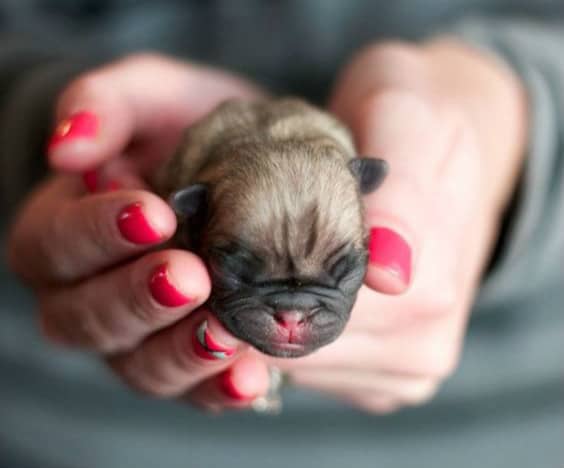Image source: Instagram
If you’re thinking of adding a pug puppy to your family you’ve come to the right place.
In this article, I’ll be providing a comprehensive lowdown on pug care from the get-go.
We will be covering everything from prenatal care to birth and moving your baby pug home.
Stay tuned for tips and tricks that will help you navigate the joys and challenges of pug care.
So, let’s get started with the first step in a newborn baby pug pup’s life.
Birth!
The birthing process
Sadly, baby pug births are renowned for their complications. Like many other brachycephalic dogs, pugs are prone to difficult births. This is often referred to as Dystocia.
Natural birth is difficult. Quite often, Mamma pug’s narrow pelvis will struggle to birth her pups’ large heads.
For this reason, the number of newborn baby pugs born by cesarean section is greater than average.
But with some careful Predelivery care you can increase your pug’s chance of natural birth.
By following these simple steps, you’ll reduce the risk for mothers and pups. So, let’s dive in.
- Make sure mum is eating a healthy diet and getting plenty of exercises
- Visit your veterinarian for a six-week ultrasound, pelvic exam, and blood sugar testing
- Put together a cosey whelping box in a quiet and comfortable location. A cardboard box with a thick layer of newspaper will suffice
- Be ready with everything you need for the birth- clean towels, scissors, rubbing alcohol, and heating pads are a great start
As the birth approaches, mamma pug will start acting a bit differently. Look out for nesting behaviors and change in appetite.
Heavy panting, straining, and whimpering are signs that birth is imminent. It’s time to get those towels ready.
It’s important to look out for signs of Dystocia. If your dog shows any of these signs you will require professional assistance and must call your vet immediately. Look out for:
- Delayed delivery
- No puppies after active labor
- No puppies after consistent straining
- Incomplete litter
- Puppies that linger in the birth canal
If you’re lucky, your pug will experience a comfortable, natural birth.
Most litters consist of between one and eight puppies in total. Puppies come out head-first in the amniotic sac. Usually, mum’s instincts will kick in quite quickly.
Don’t be surprised if you see her chew the cord, eating the afterbirth, or licking her puppies clean. This is a natural and healthy behavior.
If mamma doesn’t get round to this, however, you might need to step in and help her out.
You can cut the cord with a sterilized thread or apply some rubbing alcohol to a pair of scissors.
To remove the sac, simply open it up gently with your fingers and clear the pup’s air canal.
When the puppies start to cry this is a great sign. It means they’re breathing.
Clean them off gently with a soft towel and encourage them to start nursing from their mamma.
Newborn pups will need a lot of sleep. So be patient. They’ll have plenty of time to become the cheeky chappies we all know and love.
Newborn Pugs: The Early Days
Image source: Pinterest
Remember that newborn baby pugs are born deaf, blind, toothless, and relatively immobile.
These tiny creatures are entirely dependent on others during their early life.
Mum will help them go to the bathroom and they will need help staying warm and well-nourished.
Don’t expect your puppies’ eyes to open immediately. This will take some time. Your puppies will crawl at first.
This is completely normal. Newborn pugs cannot support their body weight yet. With time their mobility will improve.
Something to consider- pugs are prone to respiratory difficulties, so look out for breathing problems early on.
Baby Pugs: Life after 7 days
Over the first week of your puppies’ lives, they will still be nursing and sleeping much of the time.
Even after a week, newborn pug puppies are blind and deaf. With their limited mobility, they are most likely to stay close to the litter.
Things to monitor include weight and breathing. You should expect to notice a gradual increase in weight. Most baby pug puppies will double their birth weight after one week.
Remember to keep checking their breathing, even as they start to mature.
Bright eyes: Life at 2 weeks
It’s the moment we’ve all been waiting for. At the two-week mark, you should expect to see your pups’ eyes open for the first time. This is always a special moment.
Step by step, your pups will gradually start exploring. But don’t expect too much yet.
There will still be a lot of sleeping involved.
As your pups’ eyesight starts to improve, they will grow in confidence.
Keep checking their weight and make sure you’re looking out for any ocular problems as their eyes develop.
Don’t be concerned if you notice changes in your pup’s eye color. This is normal.
Pug puppies start their lives with blue eyes but as they get older their eye coloration changes.
Once maturity is reached, most pups will have dark brown eyes.
Baby Pugs From Strength to Strength: 3rd Week Milestones
At three weeks your pups should be gaining strength. They can now support their weight and move around.
This means your bundles of joy will start to come into their own. You’ll be gawking at their cuteness guaranteed.
Your puppies can now hear, urinate, and defecate independently.
As they grow in confidence, they will become fascinated by their new senses and surroundings.
Look out for their reactions as they discover the world for the first time. It’s truly magical.
At three weeks, eyesight is developing quickly. Three-week-old baby pug puppies can recognize their mother, siblings, and immediate surroundings.
This is a social time and the perfect opportunity to get your pups used to human touch. But always be gentle and go slowly.
Your pups will start to develop social skills and become more playful. Enjoy watching them interact with their littermates and get up to lots of mischiefs.
The three-week mark is also teething time. Your puppies’ first teeth will start coming through.
Curiosity in solid food will increase but, remember, mum’s milk should remain their dietary mainstay for a little while longer.
Baby Pugs: Little learners at Just 4 Weeks
At the 4-week milestone, baby pugs are starting school!
This is when your puppies will be learning about their world. You’ll see them mature and adapt their behaviors as they learn and play. Enjoy watching your litter play and tumble.
Prioritize socializing at this time and begin some basic training exercises. Yes, it’s potty training time.
Your pups’ teeth will be coming through so you might want to start thinking about weaning.
Start incorporating some solid foods as well as mum’s milk.
Glorious Food. Expect Hungry Pups by Week 5
Week five is for progress. As your pups grow in strength and confidence, it’s important to keep monitoring their progress.
Check that their weight is on a steady increase and expect to see your puppies’ appetites increase. It’s time to think about weaning.
Don’t take them off mum’s milk all at once. Weaning is a slow and steady process.
Let your pup experiment with solid foods and gradually reduce their milk consumption.
This is a delicate developmental milestone for young dogs. They might seem well adjusted but they’re still very delicate.
They will need to stay with their litter a while longer before looking for a forever home.
Nearly There. Pug Pups at 6 Weeks
By 6 weeks, it can seem that your pups are seasoned professionals at, well, being a dog. But don’t rush them to grow up too soon.
6-week-old puppies seem confident and independent. They’re fully weaned and master explorers.
But they’re not ready for the outside world just yet. Give them time to find their feet.
Baby Pugs: Expect a Confidence Wobble in Week 7
After seven weeks, your pups will have gotten used to being more independent. They’re older, wiser, and becoming more risk-averse.
They’ll be learning from their mistakes and have probably experienced their fair share of tumbles along the way.
At this stage, you must be cautious with even the most confident of puppies. Pushing a young pup too far, too soon is a recipe for disaster.
It’s important not to overwhelm them with new situations that could cause lasting anxiety and nervousness.
If your pup seems to have lost some confidence, try using counter-conditioning to get them back on track.
Week 8: Time For Baby Pugs to Leave The Nest
By week- eight, you’ll notice the darkening of your puppies’ eyes as they mature.
Now fully weaned, it’s important to offer your dogs a high-quality, balanced diet so that they continue to grow up healthy and strong.
By week eight, it’s also time for your pups to leave the nest. It’s still relatively early, but pug puppies are now sufficiently developed. It’s time to find your pups a loving family.
Pug Puppy Care Tips
We discussed our precious pups’ developmental stages. To sum up, all of this information we’ve put together some top tips that will help you every step of the way.
So let’s get down to it. Here are my 5 top tips for healthy, happy pups:
1. Have a reliable vet on hand
Even if the birth goes smoothly, you’ll need to develop a good relationship with your local vet. Your pups will need vaccinations and health check-ups throughout their life.
2. Prioritize training
Pugs are very cute, but they’re stubborn as well. It’s important to set good habits at a young age. Start training early but gradually for happy pups and happy owners.
3. Monitor your baby pug’s health
Pugs are delicate dogs. It’s important to keep an eye on their breathing and visit the vet if you have any concerns.
Clean your pup’s face regularly to prevent bacterial build-up and monitor their temperature regularly.
4. Be careful with their diet
Be mindful of your pug’s dietary needs. Portion food according to food type and age.
Remember that pugs are prone to obesity so resist those wide-eyed looks and keep treats to a minimum.
5. Get plenty of exercises but use a harness
Finally, exercise is so important for your pup’s health. Because of pugs’ flat faces, however, it’s best to use a harness instead of a traditional lead and collar which could inhibit their breathing or even result in proptosis of the eyes.
FAQs
1. Where can I get a baby pug?
You can source your baby pug pup from one of several locations. One option is to visit a certified breeder.
Make sure that they are reputable and ensure you take a visit before picking up your pup, to check out the breeding conditions.
Another way to source your pup is through a pet shop. Buying a puppy from a pet shop.
If you choose this option, I’d advise visiting in advance and meeting the team.
Ask lots of questions and make the most of their expertise.
Finally, if you’re in a position to adopt then consider visiting a shelter. Though there are no guarantees that you’ll find a pug puppy, it’s not impossible.
With so many dogs out there needing homes, rehoming an abandoned or homeless animal, pug or not, is a truly amazing thing to do.
2. How much does it cost to get a baby pug?
Depending on where you live and how you choose to source your puppy, prices will vary. In the US prices tend to range from $75-$165.
If you’re looking to buy a pug outside of the US prices will vary. Take a look at this pricing roundup for clearer international price points.
Still, Thinking of Buying a Pug?
If you’re still reading, you’re probably considering a pug of your own. That’s a great decision. Pugs can make healthy, happy, friendly companions.
Some things to remember:
- Finding a reputable breeder
- Never homing a newborn baby pug under 8 weeks old
- Monitor your baby pug’s health regularly
You’re all set. With this knowledge in your pocket, you’ll be the world’s best pug owner in no time.
Check out the video below for Pug puppies from the first day to day 33!


